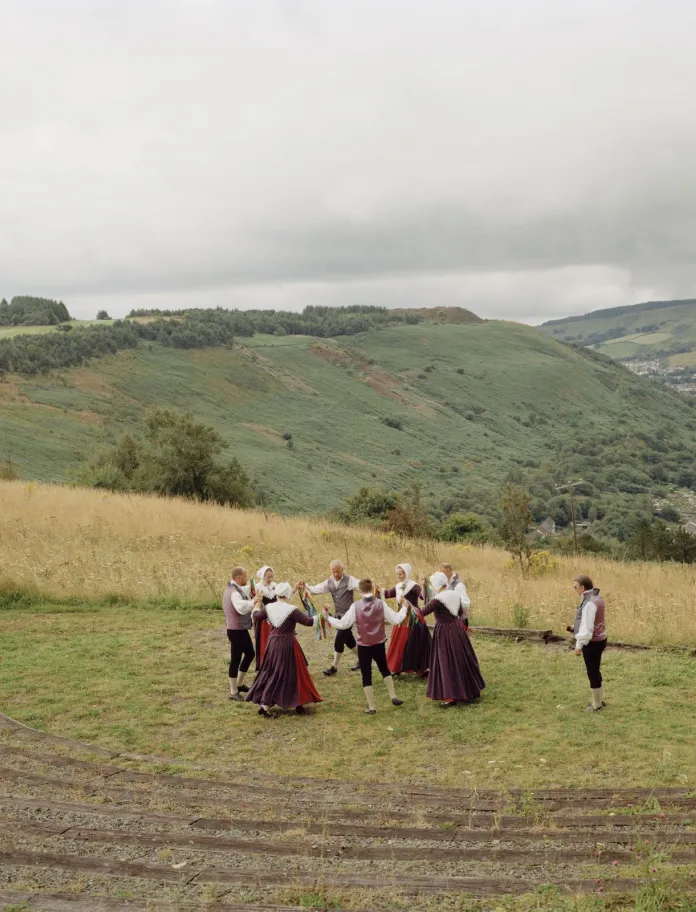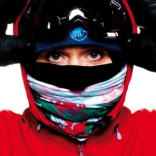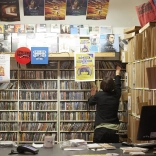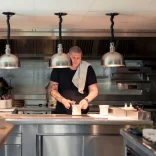We started off as a group of teachers around 1978. My wife Eirlys was teaching kids to dance and was having difficulty getting the boys to join in. One of the other teachers, who was also a rugby coach for Cardiff, suggested we form a staff dance group for a Christmas concert. The idea was that the boys could see men dancing and realise that it wasn’t a soppy thing to do. And it worked!
Everybody enjoyed the concert so much we decided to carry on. So that’s how Dawnswyr Nantgarw started.
I’m from Bala, which has a tradition of clog dancing, although I never clog danced myself until I came to college in Cardiff. But there’s a guy called Howel Wood who I remember from when I was a kid. He was of gypsy descent and worked as a farm hand in a village near Bala. He and another local farmer called Caradog Pugh kept the clog dancing tradition unbroken.
Cliff JonesI’ve clogged so much my knees have gone. My job now is passing it on to the next generation. There’s a Welsh saying: gwlad heb iaith, gwlad heb genedl. [No language, no nation.] It’s the same with dance. If the dances were to go, then a piece of Wales disappears. It’s integral to keeping the Welsh nation alive.
Mostly, though, Welsh folk dancing was stopped by the 1904 religious revival. It was only in the 1940s, when the Welsh Folk Dance Society was founded, that traditional folk dancing came back.
We chose the Nantgarw name partly because we practise there, but also because of Catherine Margaretta Thomas. She was born in 1880 and grew up in the village. She remembered the dances from before the religious revival, which had put an end to social dancing. She recalled someone closing the curtains and locking the doors so that they could dance in the house, and the deacons walking past wouldn’t be able to see them. If you were caught dancing you’d be in trouble. Any kind of physical enjoyment like that was frowned upon.
Her daughter Dr Ceinwen Thomas wrote down the dance steps that her mother had recalled and published her mother’s memories in a magazine, and there’s now a collection of Nantgarw dances.
One is a handkerchief dance called Y Gaseg Eira (The Snow Mare). Some people say that it was brought down from Staffordshire to Nantgarw by people working in the china works, because it’s very similar to one of the Morris dances from that area.

But the rest are what we call ‘fair dances’, which were danced on special festival days. One was danced on St John’s Eve to celebrate midsummer. Then there was a fertility dance, with little balls of seeds, which was danced around Easter.
Yes, it does sound quite pagan. There was a very similar tradition in Tongwynlais where the boys used to throw balls full of seeds over the church wall, and the girls would be on the other side, trying to catch them. If you caught one, it meant you’d be married during that year. Traditions like that are linked to the dances.
What about new dances? It’s the bane of my life! It’s become a big thing over the last 20 years, people writing new dances. I think they’re just taking patterns of old dances and stitching them together and calling it a dance. Usually they’re quite difficult to dance, because they don’t seem to flow naturally from one pattern to the other like the old traditional dances.
We also run a junior group called Dawnswyr Bro Taf. We’ve got about 80 kids who come every Tuesday, and we teach them traditional drama and music and dance. Bro Taf is actually going stronger than Nantgarw. There are kids coming through all the time to continue the tradition. I’ve clogged so much my knees have gone. My job now is passing it on to the next generation.
Why is it important? There’s a Welsh saying: gwlad heb iaith, gwlad heb genedl. [A land without a language is a land without a nation.] It’s the same with dance. It’s integral to being Welsh. If the dances were to go, then a piece of Wales disappears. It’s a vital part of keeping the Welsh nation alive.




